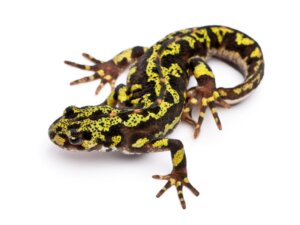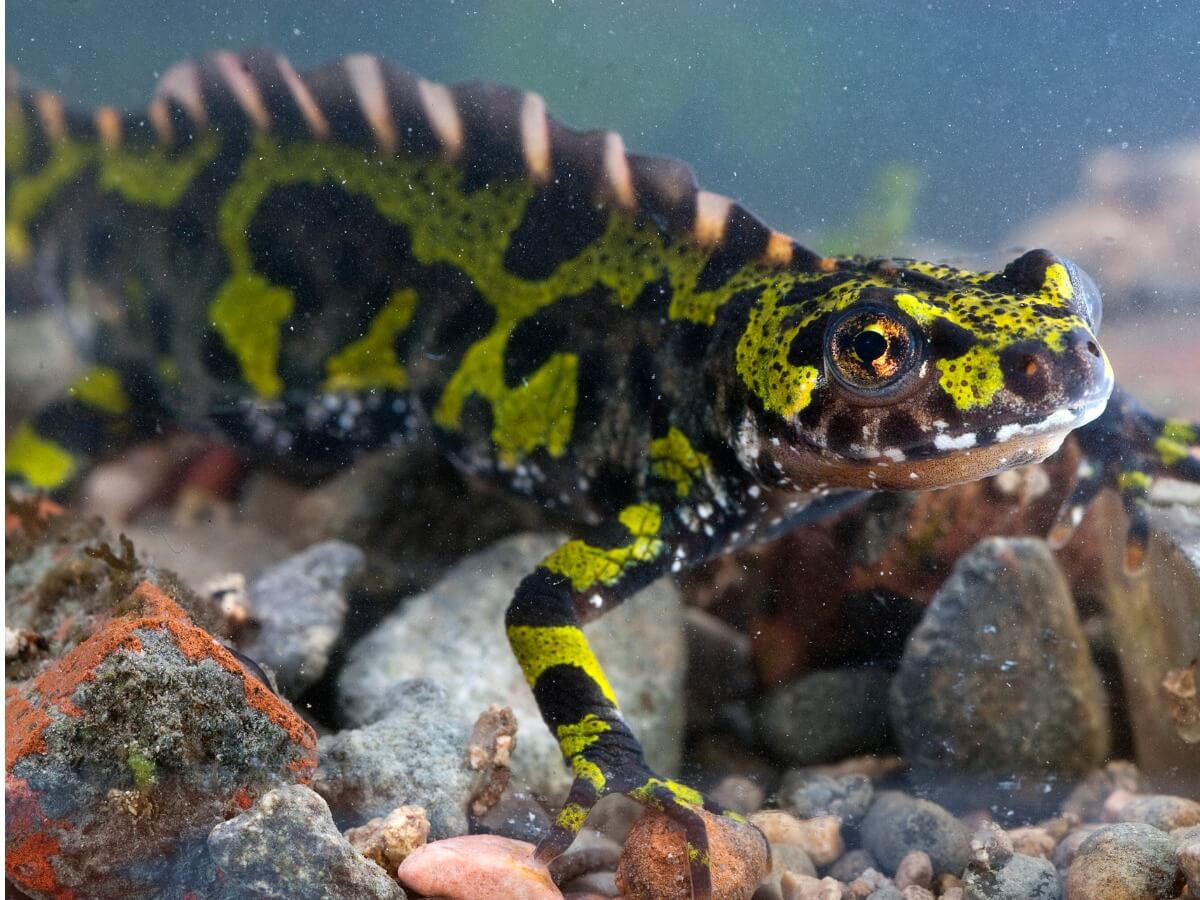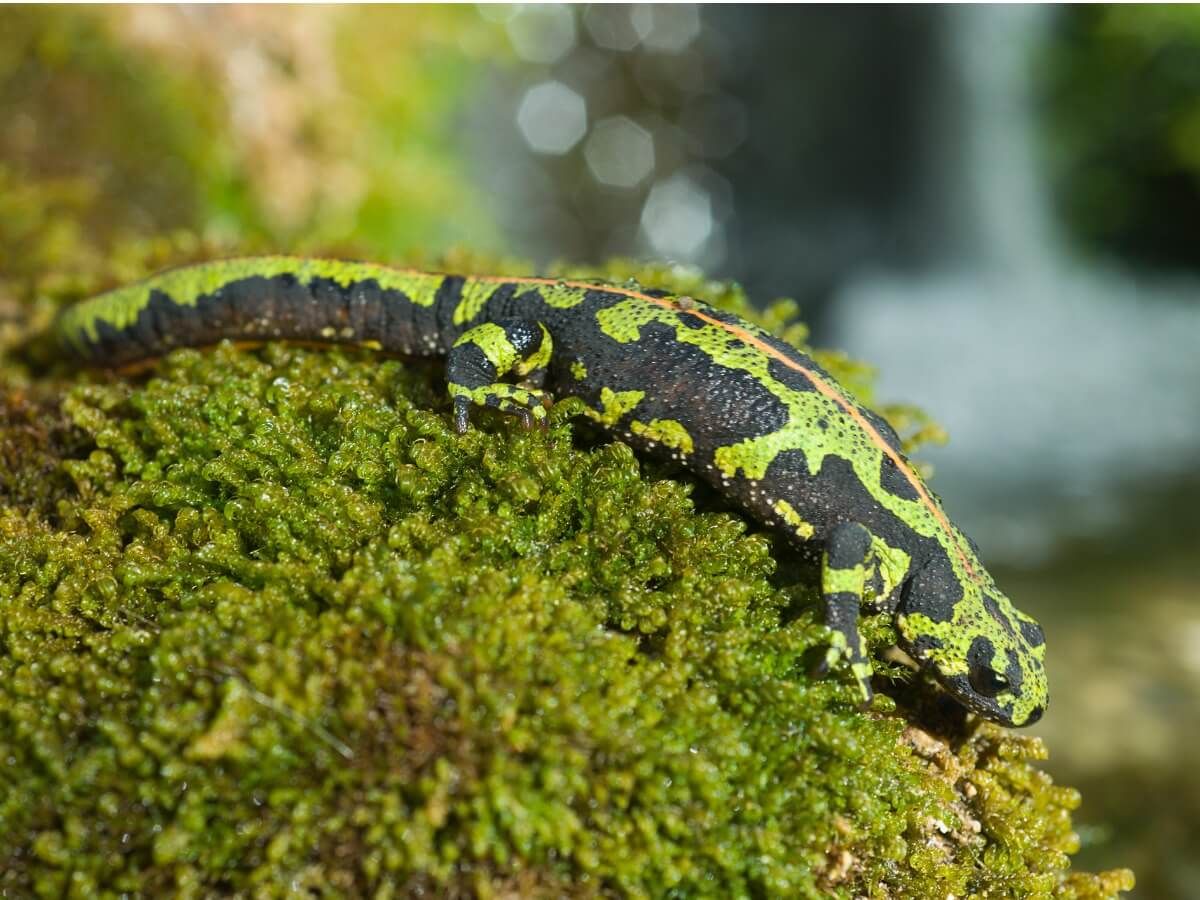Marbled Newt: Habitat and Characteristics


Written and verified by the biologist Samuel Sanchez
The Iberian Peninsula, which includes Spain and Portugal, is characterized by having the greatest biotic wealth in Western Europe. It’s estimated that some 60,000 species of animals choose these lands to proliferate, more than 50% of all those existing in the European Union. One of them is the marbled newt (Triturus marmoratus), a urodele amphibian that stands out for its colors.
Although there are more than 7,500 species of amphibians around the world, in Spain there are only about 32. For this reason, finding out about these endemic jewels in Iberian lands isn’t only a luxury, but a necessity for the preservation of this group.. Get to know the marbled newt with us, the living green jewel of the Iberian Peninsula.
Marbled newt habitat
The marbled newt is a very common urodele amphibian in Europe. It can be found throughout France, the northern half of Spain, and part of Portugal, although the further it goes towards the center of the Iberian Peninsula, the more dispersed its populations are. Similar specimens can be seen in the south of the region, but these belong to another species: Triturus pygmaeus.
Despite the fact that both species are well-differentiated, the genetic distinctions between T. marmoratus and T. pygmaeus are low, so it’s believed that there are zones of hybridization between the two. In any case, this species extends from the western coasts of Galicia and Portugal to the Eastern Pyrenees and the northern coast of Catalonia.
As an amphibian, the marbled newt is always found in habitats with water sources. However, it’s customary for it to avoid areas with currents, even if they’re moderate. They’re common animals in ponds, troughs, lagoons, reservoirs and other masses with a significant volume of water and a lot of vegetation.
This newt has a mixed life phase, that is, it spends part of the year out of the water and the other part in it.
Physical characteristics
Newts are urodele amphibians, so they have certain common traits with frogs and toads. For example, they both have bulging eyes, relatively large mouths for the size of their heads, very fine skin, and the ability to create toxins in certain special organs (although not in all cases). Of course, urodeles differ from anurans by the presence of a tail.
This species measures 13 to 17 centimeters (6 to 8 inches) and has a very characteristic greenish color, interspersed with black spots and an orange dorsal line. Its body is robust, somewhat flattened at the dorsoventral level and it has a very powerful tail, which can account for 50% of the total length. The muzzle is very broad and rounded, while the limbs are short and robust.

Sexual dimorphism
The sexual dimorphism in this species is very evident, especially in the breeding season. When they go to reproduce, the greenish tones of the males become much more striking and they develop a spectacular crest on their dorsal line that alternates black and orange tones. In addition, their cloaca becomes much more evident and globose in preparation for copulation.
Females are somewhat larger than males, although this trait may go unnoticed by the inexperienced eye.
The behavior of the marbled newt
As we said earlier, these amphibians have an aquatic and a terrestrial phase. Typically, they leave water bodies before they dry out at the end of summer and spend much of the fall and winter underground, especially when temperatures are very low. However, this doesn’t mean that in times of relative cold they don’t remain active.
Although not much is known about the terrestrial phase, specimens have been found very far from the original ponds, as indicated by Iberian Vertebrates. Unless temperatures are very low, these curious urodeles come out of their dens on rainy nights to hunt, as they don’t go into a state of total hibernation.
The marbled newt usually enters the water when the frosts and cold spikes end, as soon as February ends and March begins. From here, its aquatic phase and its reproductive frenzy begin, which we’ll see in later lines.
This animal is ectothermic, which means that it doesn’t produce enough heat to maintain its constant temperature. Therefore, in winter its activity rate is reduced to a minimum.
Feeding
As you can imagine, the feeding of the marbled newt depends on the time of year and on whether it’s in the aquatic or terrestrial phase. In any case, the basis of their menu is usually freshwater crustaceans, winged insect larvae, and spiders or millipedes sporadically. Like the rest of amphibians, it’s a carnivorous animal that bases its diet on live prey.
It has also been recorded that this species feeds on the eggs and larvae of other amphibians in an exceptional way.
Reproduction
As indicated by the Amphibia Web portal, the entire reproductive process takes place in water. The males go to the water first, while the females arrive about 15 days after the arrival of their potential mates (although they also leave later). As we’ve said, in general, this usually occurs in February-March, although there’s a lot of variation between populations.
This phase lasts about 5-6 months and is characterized by very interesting reproductive behavior. The males await the arrival of their companions at strategic points in the body of water, and when they meet one, they intercept it and begin parading themselves, moving their body, tail, and dorsal crest. Have a look at the fascinating video below!
The blow of the tail or “tailwhip” is the typical movement of the courtship phase.
When the female approves the male’s advances, he quickly deposits his spermatophore, a kind of sac that contains viable sperm. Then his partner slowly approaches and picks them up with her cloacal lips, fertilizing the internal eggs in the final step. Unlike many other amphibians, this species doesn’t embrace.
Each fertilized female produces about 250-300 eggs that she will place individually and strategically in the vegetation in the water. After 15 days, the aquatic larvae with external gills hatch, but these must develop for a further 90 days until they can colonize the land. In general, the larvae begin to leave the aquatic environment between August and September.
Conservation status
The International Union for Conservation of Nature (IUCN) lists this species as “of least concern (LC)”. However, this doesn’t mean that it isn’t threatened, as its populations are in a clear numerical decrease. At a regional level, it has been called “endangered” in France, but not in Spain and Portugal.
Some of the diseases and problems faced by the marbled newt are as follows:
- Loss and change in the use of the ecosystem, either due to climate change or the modification of the land for agricultural uses. The decrease in water masses and relative humidity greatly affect amphibians.
- Hunting for sale, something that happens in Germany and the Netherlands.
- Use of pesticides, pollutants, chemicals, and other discharges that end up in natural waters.
- Introduction of invasive species in aquatic ecosystems, such as the American crab (Procambarus clarkii). This last invertebrate is a great threat, as it eats the eggs and damages the tissues of the adults.
- Viruses, fungi, and pathogens, such as the chytrid fungus. This pathogen is highly problematic and has led to the extinction of more than 90 species of amphibians alone.

For all these reasons and many more, the marbled newt is today a protected species. Amphibians are in serious danger due to the lack of empathy and excesses of human beings. For this reason, it’s necessary to put plans in place to reintroduce these species before it’s too late. Fortunately, some organizations have already started.
The Iberian Peninsula, which includes Spain and Portugal, is characterized by having the greatest biotic wealth in Western Europe. It’s estimated that some 60,000 species of animals choose these lands to proliferate, more than 50% of all those existing in the European Union. One of them is the marbled newt (Triturus marmoratus), a urodele amphibian that stands out for its colors.
Although there are more than 7,500 species of amphibians around the world, in Spain there are only about 32. For this reason, finding out about these endemic jewels in Iberian lands isn’t only a luxury, but a necessity for the preservation of this group.. Get to know the marbled newt with us, the living green jewel of the Iberian Peninsula.
Marbled newt habitat
The marbled newt is a very common urodele amphibian in Europe. It can be found throughout France, the northern half of Spain, and part of Portugal, although the further it goes towards the center of the Iberian Peninsula, the more dispersed its populations are. Similar specimens can be seen in the south of the region, but these belong to another species: Triturus pygmaeus.
Despite the fact that both species are well-differentiated, the genetic distinctions between T. marmoratus and T. pygmaeus are low, so it’s believed that there are zones of hybridization between the two. In any case, this species extends from the western coasts of Galicia and Portugal to the Eastern Pyrenees and the northern coast of Catalonia.
As an amphibian, the marbled newt is always found in habitats with water sources. However, it’s customary for it to avoid areas with currents, even if they’re moderate. They’re common animals in ponds, troughs, lagoons, reservoirs and other masses with a significant volume of water and a lot of vegetation.
This newt has a mixed life phase, that is, it spends part of the year out of the water and the other part in it.
Physical characteristics
Newts are urodele amphibians, so they have certain common traits with frogs and toads. For example, they both have bulging eyes, relatively large mouths for the size of their heads, very fine skin, and the ability to create toxins in certain special organs (although not in all cases). Of course, urodeles differ from anurans by the presence of a tail.
This species measures 13 to 17 centimeters (6 to 8 inches) and has a very characteristic greenish color, interspersed with black spots and an orange dorsal line. Its body is robust, somewhat flattened at the dorsoventral level and it has a very powerful tail, which can account for 50% of the total length. The muzzle is very broad and rounded, while the limbs are short and robust.

Sexual dimorphism
The sexual dimorphism in this species is very evident, especially in the breeding season. When they go to reproduce, the greenish tones of the males become much more striking and they develop a spectacular crest on their dorsal line that alternates black and orange tones. In addition, their cloaca becomes much more evident and globose in preparation for copulation.
Females are somewhat larger than males, although this trait may go unnoticed by the inexperienced eye.
The behavior of the marbled newt
As we said earlier, these amphibians have an aquatic and a terrestrial phase. Typically, they leave water bodies before they dry out at the end of summer and spend much of the fall and winter underground, especially when temperatures are very low. However, this doesn’t mean that in times of relative cold they don’t remain active.
Although not much is known about the terrestrial phase, specimens have been found very far from the original ponds, as indicated by Iberian Vertebrates. Unless temperatures are very low, these curious urodeles come out of their dens on rainy nights to hunt, as they don’t go into a state of total hibernation.
The marbled newt usually enters the water when the frosts and cold spikes end, as soon as February ends and March begins. From here, its aquatic phase and its reproductive frenzy begin, which we’ll see in later lines.
This animal is ectothermic, which means that it doesn’t produce enough heat to maintain its constant temperature. Therefore, in winter its activity rate is reduced to a minimum.
Feeding
As you can imagine, the feeding of the marbled newt depends on the time of year and on whether it’s in the aquatic or terrestrial phase. In any case, the basis of their menu is usually freshwater crustaceans, winged insect larvae, and spiders or millipedes sporadically. Like the rest of amphibians, it’s a carnivorous animal that bases its diet on live prey.
It has also been recorded that this species feeds on the eggs and larvae of other amphibians in an exceptional way.
Reproduction
As indicated by the Amphibia Web portal, the entire reproductive process takes place in water. The males go to the water first, while the females arrive about 15 days after the arrival of their potential mates (although they also leave later). As we’ve said, in general, this usually occurs in February-March, although there’s a lot of variation between populations.
This phase lasts about 5-6 months and is characterized by very interesting reproductive behavior. The males await the arrival of their companions at strategic points in the body of water, and when they meet one, they intercept it and begin parading themselves, moving their body, tail, and dorsal crest. Have a look at the fascinating video below!
The blow of the tail or “tailwhip” is the typical movement of the courtship phase.
When the female approves the male’s advances, he quickly deposits his spermatophore, a kind of sac that contains viable sperm. Then his partner slowly approaches and picks them up with her cloacal lips, fertilizing the internal eggs in the final step. Unlike many other amphibians, this species doesn’t embrace.
Each fertilized female produces about 250-300 eggs that she will place individually and strategically in the vegetation in the water. After 15 days, the aquatic larvae with external gills hatch, but these must develop for a further 90 days until they can colonize the land. In general, the larvae begin to leave the aquatic environment between August and September.
Conservation status
The International Union for Conservation of Nature (IUCN) lists this species as “of least concern (LC)”. However, this doesn’t mean that it isn’t threatened, as its populations are in a clear numerical decrease. At a regional level, it has been called “endangered” in France, but not in Spain and Portugal.
Some of the diseases and problems faced by the marbled newt are as follows:
- Loss and change in the use of the ecosystem, either due to climate change or the modification of the land for agricultural uses. The decrease in water masses and relative humidity greatly affect amphibians.
- Hunting for sale, something that happens in Germany and the Netherlands.
- Use of pesticides, pollutants, chemicals, and other discharges that end up in natural waters.
- Introduction of invasive species in aquatic ecosystems, such as the American crab (Procambarus clarkii). This last invertebrate is a great threat, as it eats the eggs and damages the tissues of the adults.
- Viruses, fungi, and pathogens, such as the chytrid fungus. This pathogen is highly problematic and has led to the extinction of more than 90 species of amphibians alone.

For all these reasons and many more, the marbled newt is today a protected species. Amphibians are in serious danger due to the lack of empathy and excesses of human beings. For this reason, it’s necessary to put plans in place to reintroduce these species before it’s too late. Fortunately, some organizations have already started.
All cited sources were thoroughly reviewed by our team to ensure their quality, reliability, currency, and validity. The bibliography of this article was considered reliable and of academic or scientific accuracy.
- Comportamiento del tritón jaspeado, Vertebrados Ibéricos. Recogido a 31 de agosto en http://www.vertebradosibericos.org/anfibios/comportamiento/trimarco.html
- Triturus marmoratus, Amphibia Web. Recogido a 31 de agosto en https://amphibiaweb.org/species/4300
- Triturus marmoratus, IUCN. Recogido a 31 de agosto en https://www.iucnredlist.org/species/59477/11949129
This text is provided for informational purposes only and does not replace consultation with a professional. If in doubt, consult your specialist.








